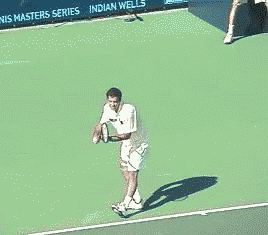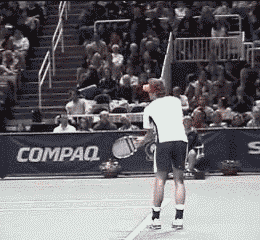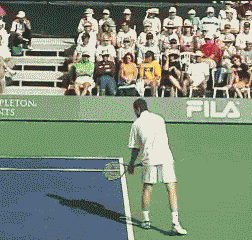|
TennisOne Lessons The Service Motion – Ground Reaction Forces by Jim McLennan The serve allows for the greatest amount of individual expression on the tennis court. Said another way, the coordination of the mechanical elements on a serve is truly daunting. For if you view just the service motions of players around you on the courts the next time you have a game, you truly see a bewildering array of styles.
Yet in the professional ranks the serves appear more or less the same. Federer, Henman, and Roddick have more in common than any three people you see at the club courts, or even within your doubles foursome. So, what I am trying to say is, the serve really is the most difficult thing for a tennis teacher to teach, and equally the most difficult (but important) thing for a student to learn. Our juniors practice the serve constantly, and rehearse the following in preparation for their college tennis tryout. Coach, “Nice to meet you kid, by the way what is the best part of your game?” Kid, “Nice to meet you coach and the serve is absolutely the best part of my game.” Coach, “Kid, take a shot at the tryouts.” My own personal journey on the serve may shed some light. American twist serves through high school and college, following the serve either to the net or to the doctor, for I incurred various shoulder injuries from the position of the contact point. Shoulder got better, played satellite tournaments and then settled into the men's open as I went to work at a club in New Orleans and then a resort in Destin. Along comes Don Kerr, a badminton/tennis coach who introduced me to “the dart in the ceiling” and “unscrewing the light bulb.” (See previous article). And though hard to learn, these two prompts changed the feeling as well as the pop on my serve.
My awareness was driven to the service action, and how the last two elements of the service whip occurred. Further, he and I patented an electromechanical teaching aide that measured said whip, emitting a whistling note when the angular momentum exceeded a preset threshold. That is, it whistled at the fastest moment within the service swing, and usually detected this peak force not at the top of the swing, but at a moment after and lower than the top of the swing. Interestingly, we experimented with Martina Navratilova, and she too coordinated the peak force at this lower and later moment. That is another story. So with this background, as a player and a coach, my focus has been on the action, and on the particular and peculiar look of Sampras and others just after contact where the hand is up and the racquet points down, endorotation of the forearm. Now, in walks Thor Besier, post doctoral student at Stanford in biomechanical engineering, armed with “The Silicon Coach.” Silicon coach is a software program that allows a comparison of multiple servers either in side by side, or overlay analysis. The serves can be synched to the point of impact and then when played forward one receives a graphic look at where the serve is either “on” or “off”. We filmed a good friend, Jon Wong, a junior on the Stanford team with a truly excellent serve, and used his images as the template for a comparative look at many servers. The results have changed my perspective. Jon used the ground better than all others, yours truly included. And using the ground leads us back to the service motion, how the large body parts are used PRIOR to the service action (the final snap of the racquet).
Toss, sink, cartwheel, swing up, snap. Service action at the end of this sequence, with a forceful snap. When sequenced correctly, the hand decelerates at the top of the swing as the racquet accelerates through the ball, toppling over the hand on the follow through. But now what of the motion, the large body parts that precede the snap. It appears to lie all within the knees. When the knees bend, how much the knees bend, how the body is balanced when the knees bend, and how the shoulders are aligned at the bottom of this knee bend. Toss and Sink Most recreational players are early with their knees, sinking and then going up WITH their toss. Too early. Watching Roddick and Henman, in the Masters in Houston, both players clearly toss the ball and then sink after the toss. A good way to practice this service motion is to begin the swing, toss the ball up, and then simply try to sink down as you catch the toss. So, how much to bend? More is better than less. Again observing the professionals (note Roddick above), they all toss and then get down, really down. No specific measures of the angle of the knee bend, but observe for yourself, the knees are really bent at this point. Ready to push on the ground, and in this case the ground will push back.
About Balance You should be absolutely centered with both legs equally bent and equally sharing the body weight. The trick here is to center as you sink. If centered with both legs equally engaged, one acquires a “dual leg drive” which produces more ground reaction force than would occur if off balance. Finally, note the line of the shoulders at the bottom of the sink. Tossing arm and left side up, well up, hitting arm and right side down, well down. At this moment you can almost draw a line from elbow to elbow, and this line points up to the ball. Now as the service motion truly begins, the hitting side will be swung UP TO THE BALL, only if the shoulders are in this position. And then the cartwheeling begins. Thank you Don. Thank you Thor. I am now reworking my serve with total focus on the motion. Next installment – turning the shoulders up and into the hit Your comments are welcome. Let us know what you think about Jim McLennan's article by emailing us here at TennisOne.
|
|||||||||||





